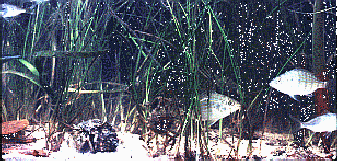Seagrass Beds
Seagrasses are flowering vascular plants that inhabit shallow areas of oceans, estuaries, and lagoons worldwide. They are the only flowering plants that live their entire lives totally in seawater. Seagrass beds are one of the most important habitats of the Indian River Lagoon.
worldwide. They are the only flowering plants that live their entire lives totally in seawater. Seagrass beds are one of the most important habitats of the Indian River Lagoon.
Seagrass beds are highly productive areas and provide critical habitat for many species of invertebrates and fishes. Seagrass beds are important elements in the lagoon's detrital food webs, and constitute important links in the mineral and nutrient cycles of the Indian River. In addition, they function as sediment stabilizers and offer protection against shoreline erosion. Seagrass beds support many threatened and endangered species such as manatees and sea turtles. They are also important foraging areas for juvenile fish and for many shore and wading birds.
Indian River Lagoon Seagrasses
Six species of seagrasses can be found in the Indian River Lagoon:
- Turtle Grass, Thalassia testudinum
- Widgeon Grass, Ruppia maritima
- Shoal Grass, Halodule wrightii
- Manatee Grass, Syringodium filiforme
- Johnson's Sea Grass, Halophila johnsoni
- Star Grass, Halophila engelmannii
The three most common species in the lagoon are shoal grass, manatee grass, and widgeon grass. Turtle grass is sparsely distributed, but may form dense beds at some locations, particularly towards the southern end of the lagoon.
Impacts to Seagrasses
Over the past 20 years, losses of seagrasses along the lagoon have been severe, with some areas losing up to 95 percent of their coverage. Other areas, however, have remained stable and productive.
Reduced light transmittance through the water column has been one of the major factors implicated in losses of seagrass coverage. Seagrass loss due to light attenuation usually starts at the outer (deeper) edge of the beds, where the light reaching the plants is only marginal, and progresses towards the shallower regions as conditions deteriorate.
Several factors are important in reducing light penetrating to a given depth of the water column:
- Absorption by phytoplankton and macroalgae.
- Suspended particle load.
- Color due to dissolved organic materials.
Phytoplankton and algal blooms are often caused by increased nutrient loads from sewage discharges and from agricultural and residential fertilizers, which run off into the lagoon. Increased nutrient levels also cause an increase in the density of epiphytes (organisms that attach to the seagrass blades and block light).
Suspended particles are introduced into the water column via runoff from commercial, agricultural, and residential areas, and also from activities within the estuary such as dredging and sediment resuspension caused by boat propellers. Dissolved organic material has many sources, including residential and commercial pesticides and fertilizers, marsh vegetation, and others.
